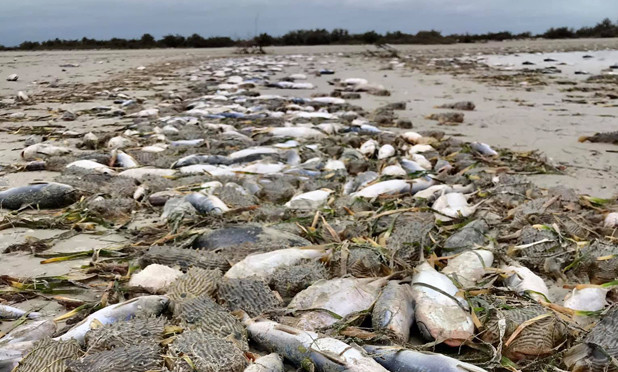 The February 2021 freeze caused a massive kill of marine life along the Texas Coast. Those dead fish and invertebrates, like oysters and worms, are in the process of decaying and will release lots of nutrients that will promote the growth of algae. Typically filter feeders, like as oysters, worms, barnacles and tiny zooplankton would gobble up excess algae. In this extreme situation; however, filter feeders themselves have died and algae they would have consumed could undergo rapid growth. “These conditions are ripe for a harmful algal bloom,” says professor Dr. Ed Buskey from the University of Texas Marine Science Institute. Dr. Buskey knows a thing or two about harmful algal blooms. He was one of the lead investigators for the region that conducted research on the brown tide bloom that persisted for over eight years in the Laguna Madre in the 1990s. That algal bloom, was a result of an extended period of drought leading to severe hypersalinity in the Laguna Madre, followed by a severe freeze, and resulting fish kill that released a large pulse of nutrients.
The February 2021 freeze caused a massive kill of marine life along the Texas Coast. Those dead fish and invertebrates, like oysters and worms, are in the process of decaying and will release lots of nutrients that will promote the growth of algae. Typically filter feeders, like as oysters, worms, barnacles and tiny zooplankton would gobble up excess algae. In this extreme situation; however, filter feeders themselves have died and algae they would have consumed could undergo rapid growth. “These conditions are ripe for a harmful algal bloom,” says professor Dr. Ed Buskey from the University of Texas Marine Science Institute. Dr. Buskey knows a thing or two about harmful algal blooms. He was one of the lead investigators for the region that conducted research on the brown tide bloom that persisted for over eight years in the Laguna Madre in the 1990s. That algal bloom, was a result of an extended period of drought leading to severe hypersalinity in the Laguna Madre, followed by a severe freeze, and resulting fish kill that released a large pulse of nutrients.
“I’m not saying for certain that there will be a harmful algal bloom,” says Buskey “but it is a very likely scenario.” The eight-year 1990 brown tide event was sustained in part because it was constrained to the Laguna Madre and Baffin Bay, which are prone to hypersalinity and low water exchange with the Gulf of Mexico. The bloom finally dissipated after heavy rains flushed the brown tide from Laguna Madre in the fall of 1997.
Buskey and his colleagues at the University of Texas Marine Science Institute are monitoring the local waters for conditions that may cause a harmful algal bloom. As research coordinator for the Mission-Aransas Reserve, Dr. Buskey has over 10-years of data with nutrient trends for local bay systems and the abundance numbers for the plankton grazers that help to eat algal blooms. “We're ready, watching and collecting data with the hope that this freeze and scenario will be different enough that there won’t be a big bloom event like in the 90s,” says Buskey. “This time, we are armed with more knowledge about how and why they persist and what can make them go away.”









